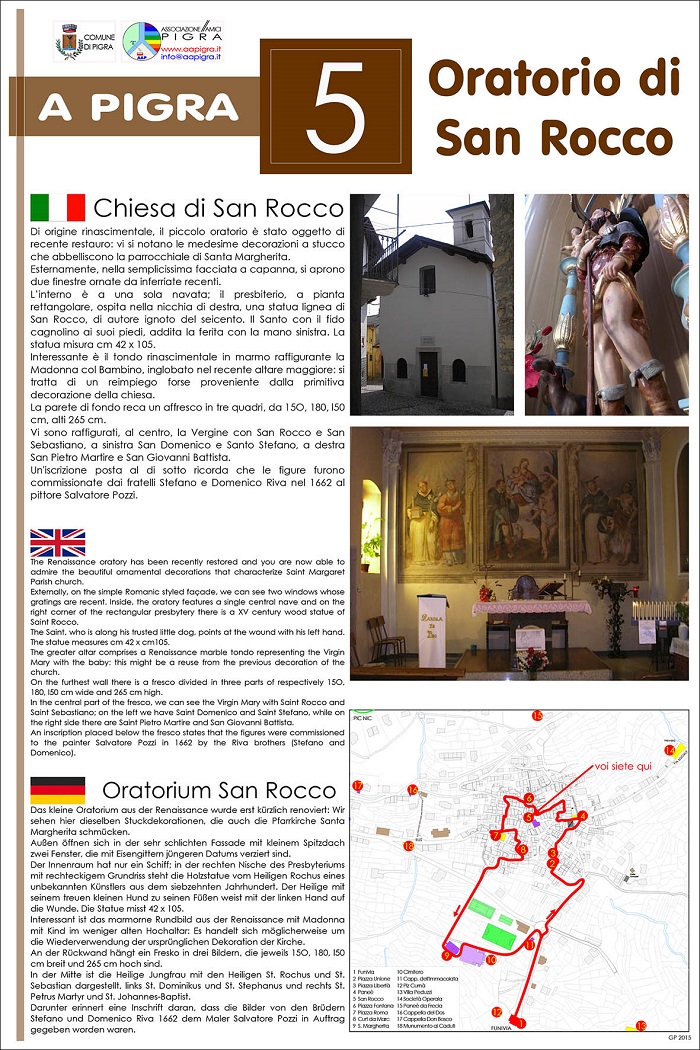 Pigra da Scoprire
Pigra da Scoprire
5 - Oratorio di San Rocco

Di origine rinascimentale, il piccolo oratorio è stato oggetto di recente restauro: vi si notano le medesime decorazioni a stucco che abbelliscono la parrocchiale di Santa Margherita.
Esternamente, nella semplicissima facciata a capanna, si aprono due finestre ornate da inferriate recenti.
L’interno è a una sola navata; il presbiterio, a pianta rettangolare, ospita nella nicchia di destra, una statua lignea di San Rocco, di autore ignoto del seicento. Il Santo con il fido cagnolino ai suoi piedi, addita la ferita con la mano sinistra. La statua misura cm 42 x 105.
Interessante è il tondo rinascimentale in marmo raffigurante la Madonna col Bambino, inglobato nel recente altare maggiore: si tratta di un reimpiego forse proveniente dalla primitiva decorazione della chiesa.
La parete di fondo reca un affresco in tre quadri, da 15O, 180, l50 cm, alti 265 cm.
Vi sono raffigurati, al centro, la Vergine con San Rocco e San Sebastiano, a sinistra San Domenico e Santo Stefano, a destra San Pietro Martire e San Giovanni Battista.
Un'iscrizione posta al di sotto ricorda che le figure furono commissionate dai fratelli Stefano e Domenico Riva nel 1662 al pittore Salvatore Pozzi.

The Renaissance oratory has been recently restored and you are now able to admire the beautiful ornamental decorations that characterize Saint Margaret Parish church.
Externally, on the simple Romanic styled façade, we can see two windows whose gratings are recent.
Inside, the oratory features a single central nave and on the right corner of the rectangular presbytery there is a XV century wood statue of Saint Rocco.
The Saint, who is along his trusted little dog, points at the wound with his left hand.
The statue measures cm 42 x cm105.
The greater altar comprises a Renaissance marble tondo representing the Virgin Mary with the baby: this might be a reuse from the previous decoration of the church.
On the furthest wall there is a fresco divided in three parts of respectively 15O, 180, l50 cm wide and 265 cm high.
In the central part of the fresco, we can see the Virgin Mary with Saint Rocco and Saint Sebastiano; on the left we have Saint Domenico and Saint Stefano, while on the right side there are Saint Pietro Martire and San Giovanni Battista.
An inscription placed below the fresco states that the figures were commissioned to the painter Salvatore Pozzi in 1662 by the Riva brothers (Stefano and Domenico).
 Das kleine Oratorium aus der Renaissance wurde erst kürzlich renoviert: Wir sehen hier dieselben Stuckdekorationen, die auch die Pfarrkirche Santa Margherita schmücken.
Das kleine Oratorium aus der Renaissance wurde erst kürzlich renoviert: Wir sehen hier dieselben Stuckdekorationen, die auch die Pfarrkirche Santa Margherita schmücken.
Außen öffnen sich in der sehr schlichten Fassade mit kleinem Spitzdach zwei Fenster, die mit Eisengittern jüngeren Datums verziert sind.
Der Innenraum hat nur ein Schiff; in der rechten Nische des Presbyteriums mit rechteckigem Grundriss steht die Holzstatue vom Heiligen Rochus eines unbekannten Künstlers aus dem siebzehnten Jahrhundert. Der Heilige mit seinem treuen kleinen Hund zu seinen Füßen weist mit der linken Hand auf die Wunde. Die Statue misst 42 x 105.
Interessant ist das marmorne Rundbild aus der Renaissance mit Madonna mit Kind im weniger alten Hochaltar: Es handelt sich möglicherweise um die Wiederverwendung der ursprünglichen Dekoration der Kirche.
An der Rückwand hängt ein Fresko in drei Bildern, die jeweils 15O, 180, l50 cm breit und 265 cm hoch sind.
In der Mitte ist die Heilige Jungfrau mit den Heiligen St. Rochus und St. Sebastian dargestellt, links St. Dominikus und St. Stephanus und rechts St. Petrus Martyr und St. Johannes-Baptist.
Darunter erinnert eine Inschrift daran, dass die Bilder von den Brüdern Stefano und Domenico Riva 1662 dem Maler Salvatore Pozzi in Auftrag gegeben worden waren.

